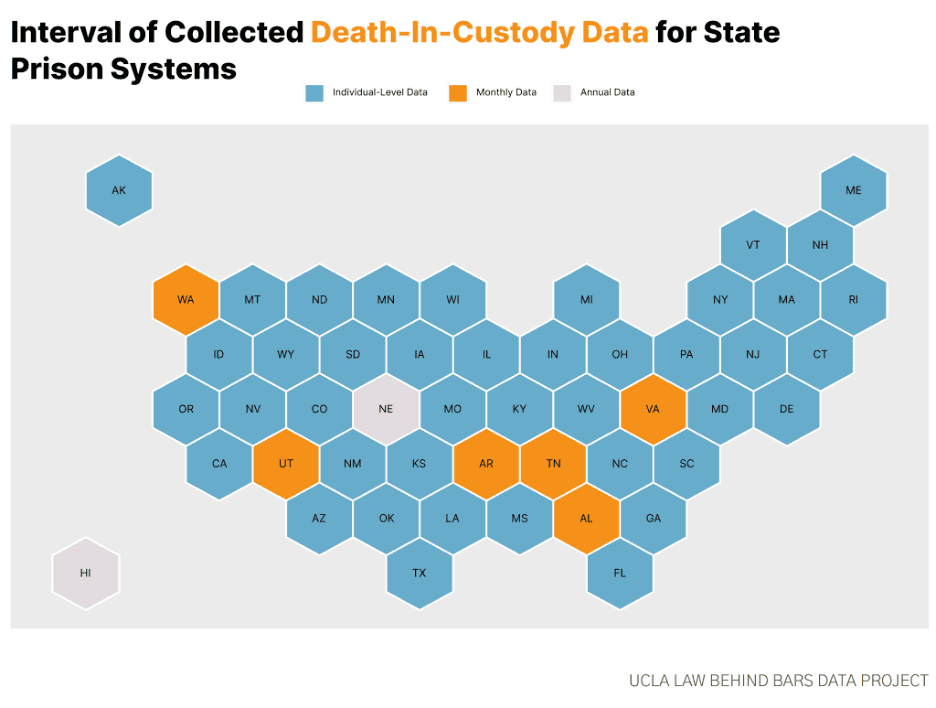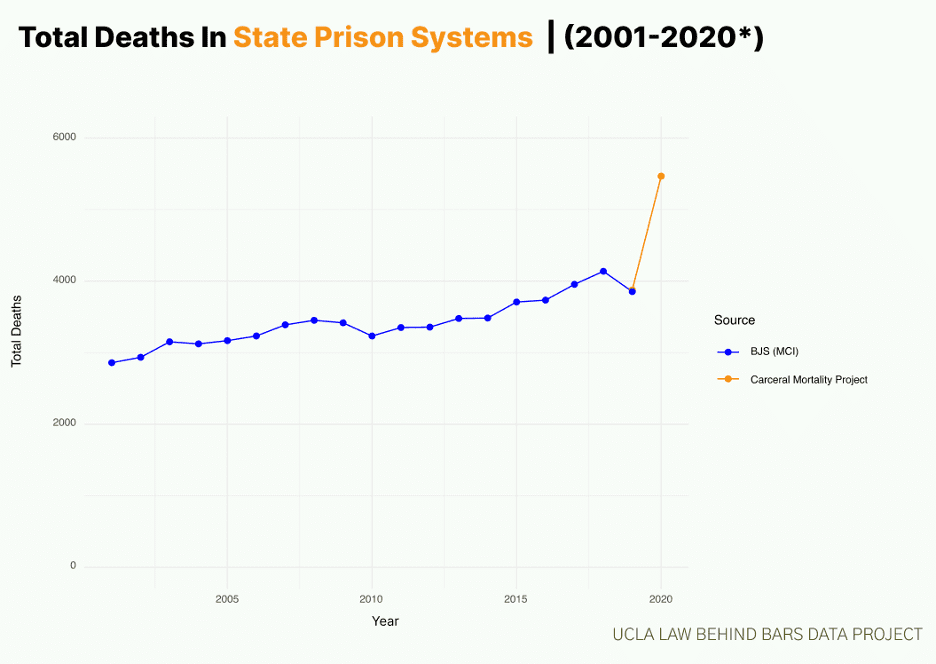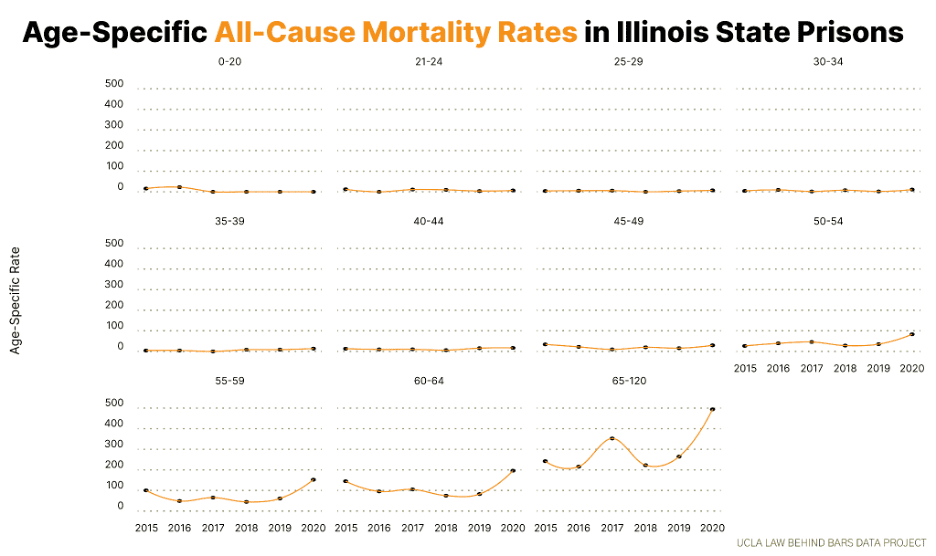February 19th, 2023 • Michael Everett and Lauren Woyczynski
UCLA Law Releases New Database to Monitor Deaths in U.S. Prisons
In 2020, at least 6,182 people died in U.S. prisons. This is a 46% increase in the lives lost behind bars from 2019, despite a 10% decrease in the overall prison population. The U.S. has seen a significant, continual increase in deaths in prisons over the past two decades, but never before have the country’s prisons seen such a steep increase year-to-year. Today, the UCLA Law Behind Bars Data Project is releasing a comprehensive public resource documenting prison deaths nationwide. Relying on each state’s public records law and publicly available reports, our team requested and gathered information on each death in U.S. prisons covering at least 2019-2020; for a few states, like Louisiana and Texas, we have relied on exceptional colleagues who had already collected the data in their states. We release this database as the federal government has failed to reliably and transparently collect data on deaths in custody and effectively ceased its own reporting of these data, abdicating a Congressionally-mandated responsibility of the U.S. Department of Justice (DOJ) since 2000.
Since the beginning of the pandemic, the UCLA Law Behind Bars Data Project has collected data from carceral agencies to document the impact of COVID on incarcerated people. However, COVID case rates and related deaths reported by carceral agencies do not reveal the full impact of the pandemic on incarcerated people. Due to inadequate and opaque testing regimens, a large and uncertain number of infections went unidentified, and at least some deaths were not properly attributed to COVID 1 2 3 4. Moreover, as the project has documented, many state prison systems have become less transparent over the course of the pandemic. Twenty-one state prison agencies no longer post data on the state of COVID in their facilities at all. These agencies were responsible for the health and welfare of over 380,000 incarcerated individuals in 2020. Finally, COVID data do not reflect deaths that were immediately caused by something other than a COVID infection but occurred in prisons where medical and security staff were overwhelmed or depleted by the pandemic.
The project’s efforts to produce public and transparent monitoring of mortality in prisons became essential in 2020 because production of detailed federal reports on prison mortality stopped, in a stroke of extraordinarily unfortunate timing, in 2019. Between 2000 and 2019, the Bureau of Justice Statistics (BJS), the statistical agency for DOJ, produced Mortality in Correctional Institutions (MCI) reports that summarized the data BJS collected under the Death in Custody Reporting Act (DCRA). DOJ determined the Bureau of Justice Assistance (BJA) will take over stewardship of data on mortality in prisons and jails through DCRA from 2019 onwards, but it will not publish any of the data, or even report them in the aggregate5.
To better assess the health impacts of COVID, understand trends in mortality, and respond to the gap left in federal reporting, our project began collecting records on deaths from all causes in prisons in June 2020. As of February 2023, our project has gathered records on deaths in prisons from every state department of corrections and the federal Bureau of Prisons. Over the last year, we have developed an open-source GitHub repository containing the records we received and machine-readable data processed from these records. We have also designed functions in R that allow users to load, summarize, and analyze data on deaths in U.S. prisons. Our project has used this code to produce summary data files that recreate some of the data files produced by DOJ from 2000-2019 for 2020. Our repository also, for the first time on a national level, allows the public to access individual- and facility-level data on deaths in U.S. prisons. Such data is essential to tracking trends in mortality behind bars, understanding the demographic characteristics of mortality and its facility-level correlates, and developing strategies to reduce the growing number of custodial deaths across the country.
This post lays out our methods for creating the database, our project’s findings on the overall change in U.S. prison mortality from 2019 to 2020, and our plans to continue reporting on and analyzing deaths in U.S. carceral facilities.
UCLA Data Collection, Attribution, and Validation
States typically mandate that prison agencies investigate and document deaths that occur while individuals are in their custody. We used public records requests, web-scraping, and other online research to gather these data. We have sent and followed up on over one hundred public records requests to obtain data from state departments of corrections. In these requests, we asked for historical data on deaths in custody through 2020, specifically including the following pieces of information for each:
- Name;
- Age, race, and sex;
- Date of death;
- Facility to which the individual was assigned;
- Location of death (e.g., cell number or hospital name);
- Type of death (e.g., suicide, homicide, accident, drugs/alcohol, illness, other);
- Additional details about the death including circumstances, cause of death, and/or details of illness (if illness is listed as type of death).
We were able to obtain records on deaths in prisons using public records requests for 43 prison agencies6. We standardized data on deaths in prisons from online PDF reports for 3 prison agencies, 7 web scraped data on deaths in prisons from agency websites for 2 prison agencies, 8 standardized data on deaths in prisons from partner projects for 2 prison agencies, 9 and we downloaded machine-readable online data on deaths in prison from 1 prison agency10.
Three years on, our project has gathered records on all-cause deaths in all state prison systems and the BOP. We have gathered complete data for 2019 and 2020 for 49 states and the BOP. The New Mexico Department of Corrections is the only U.S. prison agency that has so far not provided complete records for 2020. A request for these data has been pending with the agency since November 2022. Our project has also obtained complete records for deaths in 2021 from 28 state prison agencies.
Prison agencies provided different intervals of data on deaths in their facilities. Most state agencies, 42 in total, and the BOP, provided access to ‘individual-level’ data, meaning records that provide a specific date for each death. Seven state agencies provided data on prison deaths that were aggregated on a monthly basis, meaning the agency will report the total number of people who died in a certain month. Two agencies provided data that were aggregated on an annual basis.

Prison agencies also provided different variables for reported prison deaths. Twenty-eight agencies provided a name for individuals who died in their facilities. Forty-five agencies provided the facilities in which deaths occurred. Twenty-four agencies provided information on the race of individuals who died in their facilities. Thirty-seven agencies provided descriptions of the circumstances of deaths within their facilities. We have created a summary sheet demonstrating which variables are available for each state prison agency. As we collect more data, we will update this sheet accordingly.
As we collected these records, our project began validating them to help ensure that they were accurately capturing deaths in U.S. prisons and were comparable to the now-defunct MCI reports. To accomplish this, we compared each agency’s aggregate annual death count as recorded in past MCI reports with aggregate annual counts of pre-2020 deaths in prisons produced from gathered records. While our project identified discrepancies between these numbers, most agency totals roughly matched. The following table summarizes the largest single-year discrepancy for each state among pre-2020 data which we had federal data to compare with:
| Greatest Absolute Discrepancy in Single Year by State | Total Number | States |
|---|---|---|
| 0 death difference | 3 | KS, KY, UT |
| 1 death difference | 15 | AL, AK, AZ, ID, ME, MA, MN, NE, NM, NC, OH, RI, SC, VA, WY |
| 2 death difference | 11 | DE, IL, MI, MS, NY, ND, SD, TN, VT, WA, WI |
| 3 death difference | 4 | IA, MT, NH, NJ |
| 4 death difference | 2 | AR, IN |
| 5 death difference | 2 | OR, PA |
| 6 death difference or greater | 12 | CO, TX, HI, OK, MO, GA, MD, WV, NV, LA, FL, CA |
Only 3 states provided records that exactly matched annual totals from MCI reports. In 14 states, disparities in annual totals were substantial, with a 5 or greater difference in reported deaths in a year. The largest difference was in 2005 in California, where there were 32 more deaths in prisons reported in MCI reports compared with data obtained by our project from the California Department of Justice.
For states with a maximum discrepancy of 6 or more deaths, our project sought explanations from the relevant prison agencies. The following table lists which states we have contacted and the status of the agency’s response:
Link to discrepancy request summary sheet.
As we received responses from agencies, our project corrected the records contained in the database so they only contained deaths in prisons. For some agencies, like the Florida Department of Corrections, new sources of records were provided and then integrated into the database. After these corrections, and across all years of available data, the average annualized difference per state between aggregates from our records and aggregates from MCI reports was ~0.24 more deaths in our records, though this varied substantially by state, ranging from an average of 4.2 less deaths in our records in Colorado to 6.8 more deaths in our records in Georgia.
Link to average discrepancy summary sheet
In addition to collecting and validating the data, our project has produced summary tables illustrating total death counts and crude mortality rates for state prison agencies and the BOP. These tables resemble tables included in the formerly produced MCI reports. Crude rates and changes in population size were calculated using the Vera Institute of Justice’s People in Prison Spring 2021 Data which contains population data for 2019-2021. The following are high-level takeaways from the summary tables.
Link to prison mortality summary tables
Among prison agencies with complete data for 2020, there were 1,942 more deaths in 2020 than in 2019—a 46% increase. The crude mortality rate for these agencies increased by 62% to 47 deaths per 10,000 incarcerated individuals. The mortality rate increased more in percentage than the number of deaths because the population confined by these agencies declined by 10% between 2019 and 2020. Forty-three states saw increases in the number of deaths in prisons between 2019 and 2020. In six states, the number of deaths in prisons more than doubled between 2019 and 2020: North Dakota, Alaska, Montana, Rhode Island, New Jersey, and Michigan.

Plot context11.
Facility-Level Analysis
An essential difference between our project’s data and data historically provided in MCI reports by DOJ is that we provide facility- and individual-level information on prison deaths for most jurisdictions. All data on prison deaths provided through MCI reports are aggregated to statewide or agency-wide totals for either a specific year or series of years. BJS will not release any data publicly on a facility- or individual- level because it believes doing so would allow members of the public to identify individuals who died in carceral facilities and would violate its mandate as a federal statistical agency12. BJS will allow researchers to access their individual-level data but only after they undergo a research approval process. Researchers are additionally restricted in sharing individual-level data with others. However, many state prison agencies, in accordance with state law, regularly release information to the public on individuals who have died in their custody, including in press releases and on their websites. Additionally, as our initiative highlights, it is the national norm for prison agencies to release individual- and facility-level information on deaths in custody upon request.
Publication and analysis of facility- and individual-level data on prison deaths is essential for the full implementation of DCRA. The purposes for data collection outlined in DCRA include producing a report determining how to reduce the prevalence of deaths in custody; DOJ was to “examine the relationship, if any, between the number of such deaths and the actions of management of such jails, prisons, and other specified facilities relating to such deaths.” DOJ has not produced such a report even though one was due to Congress in 2016. Fulfilling this mandate requires fine-grained data.
Using our open-source database, researchers, journalists, community stakeholders, and members of the public can begin filling in these federal implementation gaps. As of February 2023, our project has collected facility-level data on prison deaths from 45 prison agencies, including the BOP. Of these, we have been able to connect data from 30 prison agencies to our project’s facility database, linking in contextual information like geographic location, county code, other federal facility IDs, and security level, among other variables13. Our project has leveraged this sort of data to produce facility-level analyses on COVID infection, mortality, and vaccination rates and to map facilities across the country, as we do on our homepage.
Our facility database can likewise provide necessary context for all-cause prison death data. Using complete 2019 and 2020 data for 27 prison agencies for which we have connected facility-level population data, we identified facilities with the highest percent changes in annual deaths for each state from 2019 to 2020. Such analyses can be leveraged to identify facilities with potential failures in management practices that may cause preventable deaths and to identify facilities that are successfully reducing the prevalence of custodial deaths. The facility dataset, and the capacity and population variables in particular, may be helpful in identifying places where overcrowding could be associated with worse health outcomes in a facility.
The collected data also allow for state-specific analyses. This fall we published a preliminary review of deaths in state prisons in Georgia. We found that between 2015 and 2020, the annual number of prison deaths in Georgia prisons nearly doubled (from 143 deaths in 2015 to 281 deaths in 2020).
With open-source, individual-level data, our project and the public can also conduct more specific analyses of annual changes in mortality amongst different demographic groups, including by age and race. Previous MCI reports included some data on mortality rates in different age and racial groups over time. However, these reports aggregated all state prison systems together for these purposes, preventing any analysis of mortality rates in specific jurisdictions. Using our death data and the demographic data we provide on age group distributions in prison populations, for example, our project calculated age-specific mortality rates from 2015-2020 in the Illinois state prison system.

Our data can also be used to estimate mortality rates by race to monitor inequities in health outcomes. Members of our project have used these data to measure differences in COVID mortality by racial group in the Texas state prison system. This research found that Hispanic and Black people in Texas prisons died of COVID at 2 and 1.6 times the rate of their White peers, respectively.

Next Steps
As a project committed to transparent data reporting, we have made all of the death and demographic data described above available on our GitHub. To ensure other stakeholders can continue to build upon our work, and to buttress Congressional and public access to facility- and individual-level data on deaths in U.S. carceral facilities, we have also produced documentation for each state outlining how we obtained the data and providing examples of unprocessed records. We have included functions to load and analyze these data in the database and intend to integrate these functions into our project’s R package for carceral COVID data, called “behindbarstools”. Users can review our ReadMe on GitHub to understand how to access and load our data files.
Supported by funding from Arnold Ventures, we intend to update the database and summary data tables for at least the next two years, publishing data for 2021-2023. We hope this initiative will support the DOJ in fulfilling its congressionally mandated responsibilities to collect data on all U.S. custodial deaths and study that data to reduce their prevalence. More broadly, we hope it will further other national and local endeavors intended to better monitor and reduce the significant health consequences of mass incarceration in the U.S.
- Prison agency data collected via public records requests: AK, AR, CO, CT, DE, GA, HI, ID, IL, IN, IA, KS, KY, ME, MD, MA, MI, MN, MS, MO, MT, NE, NV, NH, NJ, NM, NY, NC, ND, OH, OK, OR, PA, RI, SC, SD, UT, VT, WA, WV, WI, WY, and the BoP. 5↩
- Prison agency data collected via web scraping: AZ (Link) and FL (Link). N.B. FL also posts machine-readable rosters for their prison population that contain information on deaths in custody but because of errors in these datasets and the lack of timeline from the FLDOC for when these errors will be fixed, the project web scraped the agency’s online “Inmate Mortality” web page (Link).↩
- N.B. Plot and database currently does not include 2020 NMDOC data – records request still pending with the agency.↩
- Contextual information for carceral facilities comes from the Bureau of Justice Statistics, the Department of Homeland Security, PREA reports, and data collected independently by the project.↩
next post
February 24th, 2023
About the Carceral Mortality Project
A list of resources and relevant information for the Carceral Mortality Project.